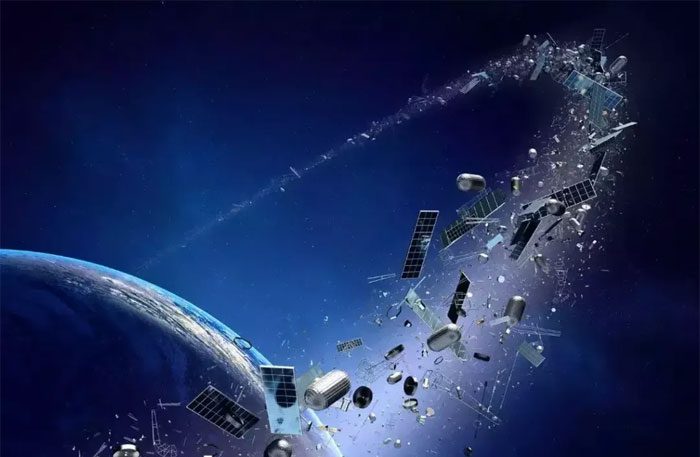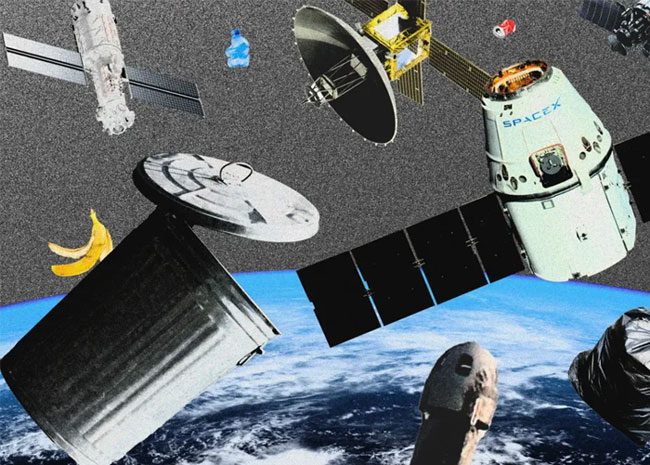While the likelihood of a bird dropping on your head is higher than the risk of space debris falling on you, it is not impossible. There have been cases of injuries and property damage caused by space debris.
As humanity continues to launch more satellites, rockets, and exploratory spacecraft into space, we face increasing dangers from space debris.

Every minute of every day, debris from space enters the Earth’s atmosphere.
A recent study published in the journal Nature Astronomy estimated the likelihood of a person being struck by falling rocket debris within the next ten years.
Every minute of every day, debris from space enters the Earth’s atmosphere. This is a danger we are largely unaware of. Microscopic particles from asteroids and comets penetrate the atmosphere and land on the Earth’s surface in unexpected ways. This adds approximately 40,000 tons of dust each year.
However, the real issue for humanity is space debris—fragments from satellites and rockets that can fall back to Earth after their missions end. They can also break apart due to collisions with asteroids or meteoroids. These are large objects that come very close to the Earth’s atmosphere, sometimes unable to be completely destroyed due to the friction of re-entry.
Using mathematical models of the tilt and orbit of rocket parts in space, their density, and 30 years of valuable satellite data, the authors estimated where rocket debris and other space junk would land as they fall back to Earth.
The study estimates that rocket bodies are more likely to fall at latitudes corresponding to Jakarta in Indonesia, Dhaka in Bangladesh, or Lagos in Nigeria, approximately three times more than in New York in the USA, Beijing in China, or Moscow in Russia.

The risk of satellite and rocket debris causing harm on the Earth’s surface is negligible.
The authors also calculated the “expected casualty rate”, meaning the risk to human life in the next decade due to uncontrolled rocket re-entries. Assuming that each time debris falls back to Earth, it disperses lethal fragments over an area of 10 square meters, there is an average 10% chance of one or more casualties occurring in the next decade.
So far, the likelihood of debris from satellites and rockets causing harm on the Earth’s surface (or in the atmosphere affecting air traffic) is negligible.
However, as the number of space companies involved in launching rockets increases, it is likely that the number of accidents caused by space debris will also rise, both in space and on Earth. A clear example is the increasing number of debris falls following the launch of the Long March 5B rocket to populated areas.
The research warns that the 10% figure is a conservative estimate.
What measures can humanity take to prevent this?
There are several technologies that can help control the re-entry of debris, but they are quite costly. For instance, spacecraft can be “passivated,” where unused energy (such as fuel or batteries) is utilized instead of being stored when the spacecraft’s operational life has ended.
Choosing orbits for satellites can also reduce the chances of generating debris. A defunct satellite can be programmed to move into a low Earth orbit and will burn up before falling to the surface.
Additionally, there are efforts to launch reusable rockets, such as those successfully developed and safely operated by SpaceX. Blue Origin is also in development. These generate significantly less debris, though there will still be some fragments from paint and metal when they return to Earth.

Reusable rockets generate significantly less debris.
The European Space Agency plans a mission to attempt to capture and remove space debris using a special robot. The United Nations, through its Office for Outer Space Affairs, issued a set of guidelines for space debris mitigation in 2010, which were updated in 2018.
However, these are guidelines, not international laws, and do not provide specific details on how to implement or control debris mitigation activities.
The research team argues that only by applying the most advanced technologies and planning missions more meticulously can we reduce the rate of uncontrolled re-entries. Above all, there needs to be a common solution applied to all countries to control the re-launching of rocket bodies.
In five years, it will be 70 years since the first satellite was launched into space. It would be a wonderful celebration if it could be marked by an international treaty mandating the control of space debris, approved by the United Nations. Certainly, every country would benefit from the safety provided by such a treaty.





















































